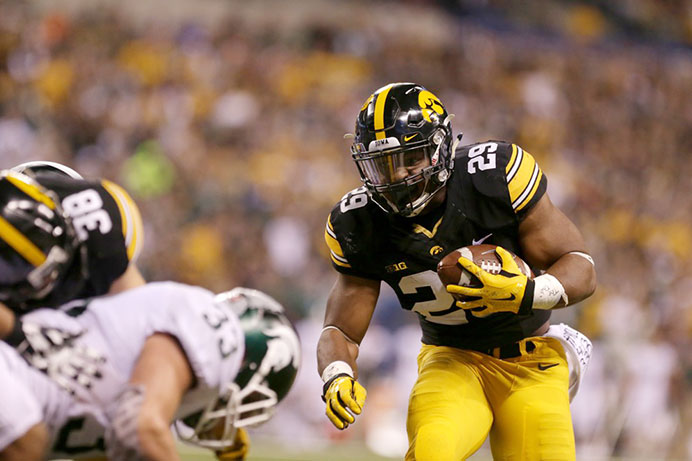Running, stopping the run, and quarterback play will be central in Iowa’s matchup with Stanford.
By Charlie Green
Rush yards allowed per game: 146.9 (44th nationally)
In the Big Ten Championship Game, Iowa showed its offense is best suited to build off a strong run game. The failure to establish it against Michigan State proved costly.
Stanford hasn’t been quite as stingy against the run as the Spartans. The Cardinal come in allowing 146.9 yards per game. Against the Hawks they will see a pro-style attack much like their own, and much different from some of the spread attacks they are accustomed to seeing on the West Coast.
Traditionally strong against the run, Stanford is led by senior defensive lineman Aziz Shittu. Shittu is a first-team All-Pac 12 player with 8.5 tackles for loss.
Joining him in the front seven is another first-teamer: senior linebacker Blake Martinez. Martinez ranks ninth in the country in tackles.
Whether the Hawkeyes find success on the ground could determine who comes out on top.
Rush yards per game: 225.1 (19th nationally)
Stanford, like Iowa, prides itself on physical play. Much as the Hawks will look to get their run game going, the Cardinal will look to do the same.
Heisman Trophy runner-up Christian McCaffery makes that possible. The sophomore ran for 1,847 yards and eight touchdowns in 2015. He is used to heavy workloads, also contributing as a return man and receiver.
But his team has other options as well. Between Barry Sanders, Bryce Love, Remound Wright, and quarterback Kevin Hogan, the team has totaled another 1,000 yards rushing. And Wright is the man to watch around the goal line — the 5-foot-9 senior rushed for 13 touchdowns.
Seniors Joshua Garnett and Kyle Murphy are two of the best offensive linemen in America.
Hogan’s quarterback rating: 170.1 (5th nationally)
Stanford’s passing attack has been less potent than its ground game, but it has one of the best quarterbacks in college football.
Hogan has thrown 24 touchdowns to just seven interceptions. He is the fifth-most efficient quarterback in the country.
McCaffrey is his leading receiver with 41 catches and 540 yards. Tight end Austin Hooper is a Pac-12 first teamer as well. There are not a lot of game-changing targets for Hogan in the pass game, particularly downfield.
But as experienced and talented as he is, Hogan brings valuable balance to this group when opponents want to load the box and key on McCaffery.
Third-down efficiency: 51.2 percent (third nationally)
No statistic ties the Cardinal offense together more than this one. Stanford converts on 51.2 percent of its third downs, a mark that puts it third in the nation. The strong run game often puts it in third-and-short situations, but if not it has a quarterback in Hogan that gives it a chance to convert anyway.
Given the way Iowa has played on third down over its last two games (3-for-21), the edge Hogan and the Cardinal hold could allow them to dominate time of possession — much in the way Michigan State did in the Big Ten Championship.
Stanford’s offense stays on the field. And if Iowa can’t come up with stops on third down, its defense could be facing an uphill battle in the fourth quarter once again.



